The Reusable Wine Bags Market is estimated to be valued at USD 1.6 billion in 2025 and is projected to reach USD 2.7 billion by 2035, registering a compound annual growth rate (CAGR) of 5.5% over the forecast period.
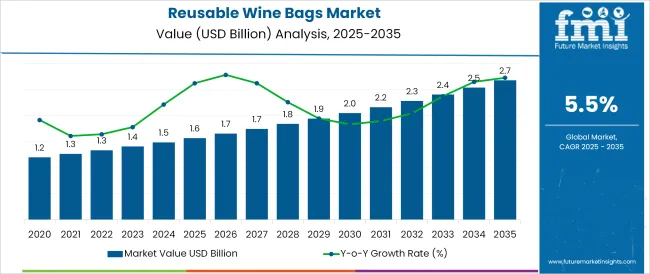
The reusable wine bags market is witnessing steady growth, driven by increasing consumer focus on sustainability and premium gifting experiences. Consumers and retailers are demanding elegant, reusable packaging solutions that offer protection, longevity, and style.
Brands and manufacturers are responding by integrating durable, eco‑friendly materials and custom-fit designs that enhance user convenience while reducing single-use waste. Market participants are leveraging partnerships with vineyards, wineries, and e-commerce platforms to drive brand visibility and broaden distribution.
Future growth is expected through innovations such as insulated linings, personalization options, and modular packaging that can accommodate larger or unconventional bottle shapes. Regulatory encouragement for sustainable packaging and growing interest in eco-conscious wine tourism and gifting trends are expected to further stimulate demand. Expansion opportunities lie in emerging markets where the wine culture is growing and consumer awareness for reusable packaging is rising.
The market is segmented by Material Used, Fastening Type, and Number of Compartments and region. By Material Used, the market is divided into Leather, Paper, Jute, Plastic, and Others. In terms of Fastening Type, the market is classified into Velcro, Zipper System, Open Bag, Knot Based System, and Clasp System.
Based on Number of Compartments, the market is segmented into Single Bottle Wine Bags and Multi Bottle Wine Bags. Regionally, the market is classified into North America, Latin America, Western Europe, Eastern Europe, Balkan & Baltic Countries, Russia & Belarus, Central Asia, East Asia, South Asia & Pacific, and the Middle East & Africa.

The leather material subsegment is projected to hold a 28.0% revenue share in 2025, making it the leading material category in the market. Its dominance is being driven by perceived premium quality, durability, and fashionable appeal that resonate with upscale consumers.
Sophisticated craftsmanship and branding opportunities such as embossing and bespoke finishes have elevated leather wine bags to status symbols, enhancing gift presentation and experience. High resilience and long product life cycles reduce replacement frequency, contributing to better cost-per-use ratios.
Environmental preferences for durable and reusable goods have supported leather’s position, while innovative, responsibly sourced, and vegan leather varieties have expanded the appeal for conscious consumers. These factors have collectively sustained leather material’s lead in market share.
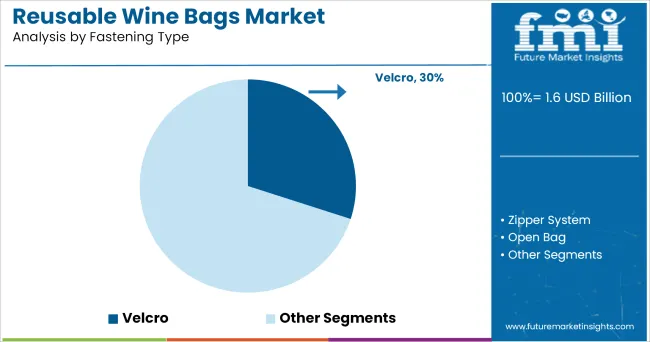
The velcro fastening subsegment is expected to secure a 30.0% share of the reusable wine bags market in 2025, supporting its status as the top fastening type. Its leadership is attributed to the convenience, reliability, and cost‑effectiveness of the closure mechanism.
Fast and secure access is favored by both consumers and retail gifting channels. The simplicity of velcro-enabled design has reduced production complexity and margins, making it attractive for mid-range and volume-driven products.
Ongoing improvements such as silent-opening strips, tighter adhesion, and more discrete designs are enhancing user experience. The balance of usability and affordability provided by velcro fastening has sustained its leading position in the market.
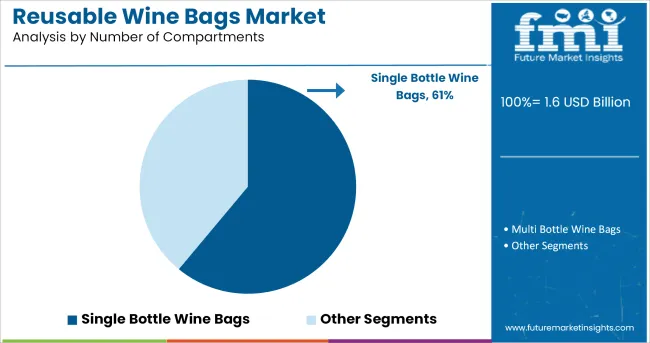
The single bottle wine bag subsegment is anticipated to command a strong 61.00% market share in 2025, establishing it as the leading compartment configuration. This predominance is being driven by consumer preference for individual bottle presentation, which complements trends in gifting, tastings, and personal consumption.
Single‑bottle designs offer optimal protection, ease of transport, and opportunity for customization attributes favored in both retail and direct-to-consumer channels. Their simplicity in production and reduced material complexity have allowed manufacturers to maintain competitive pricing and speed of fulfillment.
Additionally, single bottle bags align well with sustainability goals due to their smaller, more efficient design footprint. These combined benefits have positioned the single bottle category as the backbone of reusable wine bag offerings.
Wine is a preferable choice to uplift the mood during any situation and is preferred as a sophisticated drink for celebrations. Wine enthusiasts collect various wines and preserve them for years to allow the beverage to ferment on its own to improve the quality and taste.
Wine bags help in the safe storage of expensive and rare wine bottles. Some wine bags are made up of materials such as plastic, neoprene and others allow the wine to maintain a standard temperature.
Reusable wine bags are packaging items that are utilized for safe coverage and storage, but nowadays are also majorly used as a luxury item to attract more customers by improving the outlook. These wine bags are sold at the market along with the wine. Some wine manufacturers prefer to showcase their brand name and logo to promote the brand image.
With the awareness of environmental issues and environmental hazards caused due to the mass dumping of various items. This creates a rising demand for reusable or disposable packaging items such as reusable wine bags. These bags are very sustainable for every environment-conscious consumer.
The customization of reusable wine bags is gaining traction in the market as customers gift wine bottles on special occasions to friends, families and business deals. Personalized messages on the reusable wine bags give a more emotional touch that improves its aesthetic values. These attributes favour a lot in the increasing sales of reusable wine bags in the market.
The threat of substitutes such as cartons, cardboard boxes, plastic bags, pouches, bag-in-bag box and many others have notably decreased the demand for reusable wine bags.
Also, the regulations related to overconsumption of alcohol owing to health problems can also hamper the growth of the reusable wine bags market share.
Governmental policies regarding environmental issues, reduction in the consumption of materials that are bio-degradable in nature, and minimizing wastages have created a major opportunity for manufacturers to increase the production of reusable wine bags.
The involvement of middle and upper-class demography owing to the increased disposable income and the way of living a luxurious lifestyle has prompted an increase in the opportunities for new entrants to thrive in the competitive market.
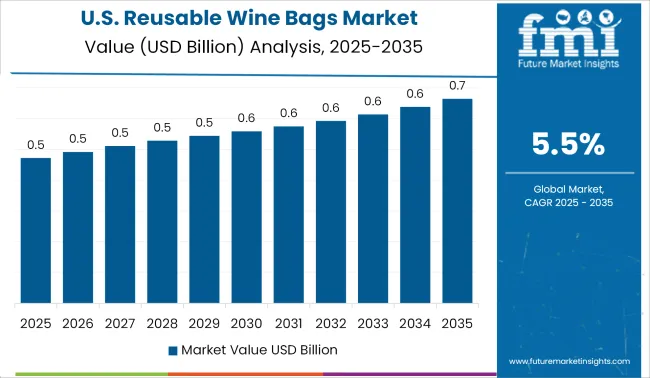
This region has the highest number across the globe in terms of consumption of wine which directly impacts the sales of wine bags in a positive manner. Presence of major key players and the increase in consumption of wine is fueling the growth of reusable wine bags market.
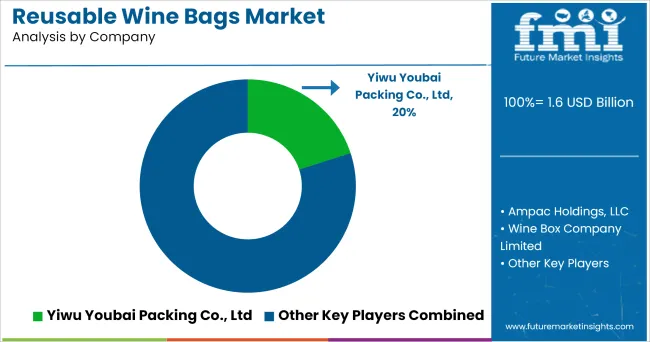
Key global players of the Reusable Wine Bags Market:
Key players in the Asia Pacific region of the Reusable Wine Bags Market:
The global reusable wine bags market is estimated to be valued at USD 1.6 billion in 2025.
The market size for the reusable wine bags market is projected to reach USD 2.7 billion by 2035.
The reusable wine bags market is expected to grow at a 5.5% CAGR between 2025 and 2035.
The key product types in reusable wine bags market are leather, paper, jute, plastic and others.
In terms of fastening type, velcro segment to command 30.0% share in the reusable wine bags market in 2025.






Full Research Suite comprises of:
Market outlook & trends analysis
Interviews & case studies
Strategic recommendations
Vendor profiles & capabilities analysis
5-year forecasts
8 regions and 60+ country-level data splits
Market segment data splits
12 months of continuous data updates
DELIVERED AS:
PDF EXCEL ONLINE
Industry Share Analysis for Reusable Wine Bags Companies
Reusable Water Bottle Market Forecast and Outlook 2025 to 2035
Reusable Box Market Forecast and Outlook 2025 to 2035
Reusable Crate Welding Lines Market Size and Share Forecast Outlook 2025 to 2035
Reusable Transport Packs Market Size and Share Forecast Outlook 2025 to 2035
Reusable Oil Absorbents Market Size and Share Forecast Outlook 2025 to 2035
Reusable Grocery Tote Market Analysis - Size and Share Forecast Outlook 2025 to 2035
Reusable Period Panties Market Analysis - Size, Share, and Forecast Outlook 2025 to 2035
Reusable Tumblers Market Size and Share Forecast Outlook 2025 to 2035
Reusable Laparoscopic Instruments Market is segmented by Reusable Laparoscopic Scissors and Reusable Hand Instruments from 2025 to 2035
Reusable Incontinence Products Market Analysis - Size, Share & Forecast 2025 to 2035
Reusable Nursing Pads Market Size and Share Forecast Outlook 2025 to 2035
Reusable Cold Chain Packaging Market Size and Share Forecast Outlook 2025 to 2035
Reusable Packing Market Size, Share & Forecast 2025 to 2035
Reusable Straws Market Analysis - Trends, Growth & Forecast 2025 to 2035
Reusable Sanitary Pads Market Growth - Size, Demand & Forecast 2025 to 2035
Reusable Egg Containers Market Trends – Growth & Forecast 2025 to 2035
A Detailed Global Analysis of Brand Share for the Reusable Incontinence Products Market
A Detailed Global Analysis of Brand Share for the Reusable Period Panties Market
Evaluating Reusable Cold Chain Packaging Market Share & Provider Insights

Thank you!
You will receive an email from our Business Development Manager. Please be sure to check your SPAM/JUNK folder too.
Chat With
MaRIA